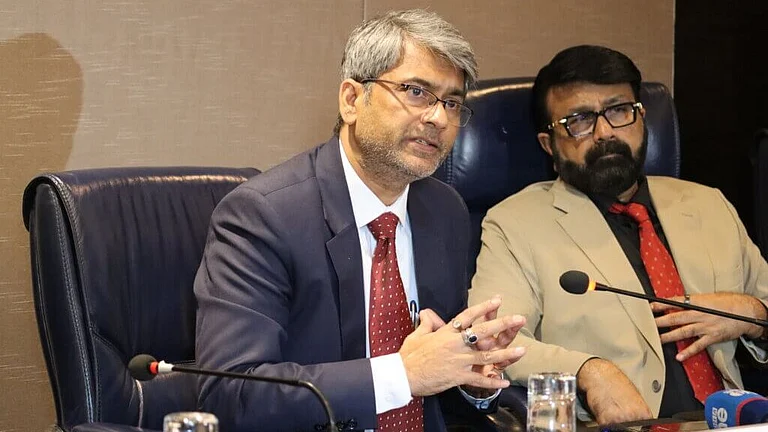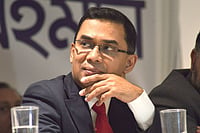THIS is an age of instant gains, and the arts, obviously, do not remain unaffected. Simply put, it is extremely difficult for a dancer to retain his or her sanity. Here you are, confident, with a good training and background, eager to make an impression, but waiting endlessly for a performance, while a few chosen ones who know how to manipulate the media are racing ahead featured again and again in magazines and newspapers. After a few feeble attempts to break the system, one would rather take up computer science and leave for the States!
Traditional patrons are extinct, new ones hard to come by. Yet dancers persevere. It is an inner search for excellence that we all strive for thats how great artistes have survived against all odds. But, we should also not forget that its societys responsibility to encourage and support artistes If dancers today are selfish, mean and opportunistic, the fault lies as much with the system as with them.
One of the tenets of Bharatas Natyashastra says: "The actor (or artiste) who had the power and skill of creating another world, could at no time be arrogant or egoistic. He could be worthy of an exalted place, as also his art, only if he had discipline, self-restraint, and humility." Lets honestly admit that most of us have transgressed these rules. Today, the substance of art is a forgotten thing, personality projection is more important. It has come about due to various factors which are slowly reducing dance to a glossy package deal rather than a professional and aesthetic pursuit.
Dancers have to literally beg for programmes. There is a paucity of impresarios. Those that style themselves thus, demand advertisements, sponsorships. Many highly qualified artistes cannot get through this system. Its the affluent dancers, splurging money, soliciting publicity, who Suffice to say that you have to constantly fight for your right to perform. Merit alone doesnt count with people, because most of the selections are based on personal likes and dislikes. Consequently, those that do get through on merit are also viewed with suspicion.
There should be effective checks within the system to ensure this doesnt happen. Dancers, too, must not adopt unethical means to get programmes, not run to ministers and other powerful people for sponsorship and grants. Sponsors, selectors, government bodies, must check favouritism in matters of selection. The media, on its part, can help in projecting the true value of an art ists achievements.
Reading magazines and newspapers only gives me cause for concern. A few dancers are consistently projected as torch bearers of the dance community. Once, after we received the Delhi Sahitya Kala Parishad Award, a media person asked us to make some sensational comments to provide good copy. Is it an art ists responsibility to create sensationalism? Attend high society parties? Have extra-marital affairs? Talk on erotica rediscovered? Comment on subjects as assorted as cricket and corruption? Recently, I read in a gossip column how Sringara rasa has been re discovered in dance thanks to the contribution of a great artist. May I ask when this rasa was absent? Should not a more knowledgeable person write such an article after a bit of research? Newspapers have no room for critics to write a decent review, but they have plenty of space for gossip columns!
There are exceptionally good artistes in this country. They seem to have no right to be heard. Or seen! The media has successfully created a hierarchy of dancers. A debutante is called a star because of a high-profile presentation. Equally talented artistes dance in empty halls. The so-called czars and czarinas of culture have no time to attend or assess the perf o rmance of a dancer with humble means, but they never miss glitzy evenings. Unfortunately these are the people who decide the fate of an artist, and give audiences the erroneous impression that the people they write about are the only ones worth watching.
ONE can well imagine, when we dont raise our voice over the gravest social issues, whos going to spare a thought for such secondary matters like the performing arts? It only matters to the artists who silently suffer year after year. The message you are not good enough. The whole scenario seems to be dominated by personal choices. The policy makers and government agencies depend heavily on an expert committee of advisers that have strong biases reinforced by self-projecting lobbyists. Their opinion seals the fate of a dancer. Theres no system to check whether the rejected artist deserves another chance. The selectors say they want top artists well, theyre top because theyre selected repeatedly! I dont understand the secrecy that surrounds the composition of selection committees. Why should someone be appointed for 10-20 years in the same committee? Why these monopolies?
There should be a forum where a dancer can lodge a formal complaint if ignored. Private sponsorship and performances can be a matter of personal choice, but dancers have a right to perform in state and central government - sponsored events. I believe there is enough scope for every good a rtist once a more objective process of selection is adopted. Im not talking of quantity over quality, agencies and sponsors can easily refer to a list of good artists in each form of art culled by experts. A simple rotation system can ensure that better artistes are given important assignments. The media can help by giving some space to younger artistes. There is a delicate balance involved in giving proper patronage and encouragement to the right persons. Changes in attitudes are necessary. It is not possible to correct the system in one day, but I feel many factors will coalesce to bring about changes in the realm of dance.


























